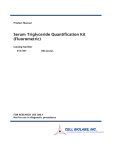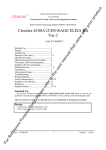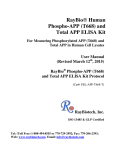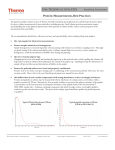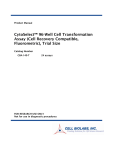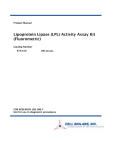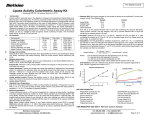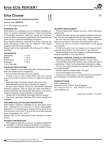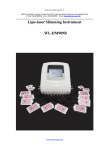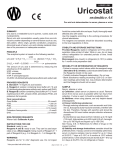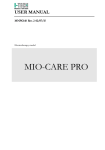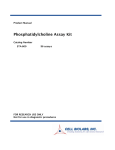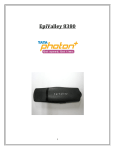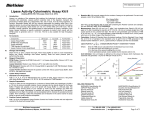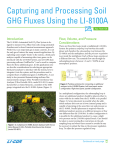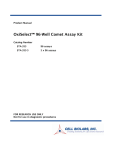Download Serum Triglyceride Quantification Kit (Colorimetric)
Transcript
Product Manual Serum Triglyceride Quantification Kit (Colorimetric) Catalog Number STA-396 100 assays FOR RESEARCH USE ONLY Not for use in diagnostic procedures Introduction Triglycerides (TAG) are a type of lipid in the blood, serving as an energy source and playing a key role in metabolism. Triglycerides are the digestive end product of breaking down dietary fats. Any extra carbohydrates and fats that are not immediately used are chemically converted into triglycerides. In the intestines, secreted enzyme lipases hydrolyse the triglyceride ester bond, yielding glycerol and free fatty acids in a process called lipolysis. Enterocytes then absorb and repackage the fragments with cholesterol to form chylomicrons, a major lipoprotein transport particle. In the liver, hepatic lipases also break down triglycerides to assemble another lipoprotein particle (VLDL) from triglycerides, cholesterol, and apolipoproteins. Cell Biolabs’ Serum Triglyceride Quantification Kit measures triglyceride concentration in serum, plasma, and lysates by a coupled enzymatic reaction system. First, lipase hydrolyzes the triglyceride ester bond, yielding glycerol. The glycerol is then phosphorylated and oxidized, producing hydrogen peroxide which reacts with the kit’s Colorimetric Probe (absorbance maxima of 570 nm). The Serum Triglyceride Quantification Kit is a simple, colorimetric assay that quantitatively measures the amount of triglyceride in plasma, serum, and lysates in a 96-well microtiter plate format. Each kit provides sufficient reagents to perform up to 100 assays, including blanks, triglyceride standards, free glycerol controls and unknown samples. The kit contains a triglyceride standard and has a detection sensitivity limit of ~10 µM (1 mg/dL). Related Products 1. STA-241: Human Low Density Lipoprotein 2. STA-242: Human Very Low Density Lipoprotein 3. STA-361: Human ApoAI and ApoB Duplex ELISA Kit 4. STA-368: Human ApoB-100 ELISA Kit 5. STA-369: OxiSelect™ Human Oxidized LDL ELISA Kit (MDA-LDL Quantitation) 6. STA-375: Uric Acid/Uricase Assay Kit 7. STA-378: Creatinine Assay Kit 8. STA-390: Total Cholesterol Assay Kit 9. STA-391: HDL and LDL/VLDL Cholesterol Assay Kit 10. STA-397: Serum Triglyceride Quantification Kit (Fluorometric) 11. STA-398: Free Glycerol Assay Kit (Colorimetric) 12. STA-399: Free Glycerol Assay Kit (Fluorometric) Kit Components 1. Triglyceride Standard (Part No. 239601): One 200 µL vial (equivalent to 20,000 mg/dL triglyceride mixture with average MW of 873). 2. 10X Assay Buffer (Part No. 239802): One 1.5 mL vial. 2 3. 10X Lipase Solution (Part No. 239602): One 1 mL vial. 4. 5X Enzyme Mixture (Part No. 239803): Four 525 µL vials. 5. 200X Colorimetric Probe (Part No. 239804): One 55 µL amber vial. Materials Not Supplied 1. 2. 3. 4. 5. 96-well microtiter plate 10 µL to 1000 µL adjustable single channel micropipettes with disposable tips 50 µL to 300 µL adjustable multichannel micropipette with disposable tips Multichannel micropipette reservoir Microplate reader capable of reading at 570 nm Storage Store entire kit at -80ºC. Avoid multiple freeze/thaws by aliquoting. The Colorimetric Probe is light sensitive and should be maintained in amber tubes. Preparation of Reagents • Triglyceride Standard, 10X Assay Buffer, 10X Lipase Solution, and 5X Enzyme Mixture should be thawed/maintained at 4ºC during assay preparation. All are stable for 1 week at 4ºC. For longer term storage, each should be aliquoted and frozen at -80ºC to avoid multiple freeze/thaws. • 200X Colorimetric Probe should be thawed/maintained at room temperature during assay preparation. Any unused material should be aliquoted and frozen at -80ºC to avoid multiple freeze/thaws. Preparation of Triglyceride Standard • To prepare the triglyceride standards, first perform a 1:100 dilution of the stock Triglyceride Standard in deionized water. Prepare only enough for immediate use (e.g. Add 10 μL of 20,000 mg/dL Triglyceride Standard to 990 μL deionized water). This solution has a concentration of 200 mg/dL. Use this 200 mg/dL triglyceride solution to prepare standards in the concentration range of 0 – 40 mg/dL by further diluting in deionized water (e.g. Add 200 µL of 200 mg/dL triglyceride solution to 800 µL deionized water - see Table 1 below). Triglyceride diluted solutions and standards should be prepared fresh. Standard Tubes 1 2 3 4 5 Final Final Deionized Triglyceride Triglyceride Water Standard Standard (µL) (mg/dL) (µM) 800 40 458 250 20 229 250 10 114.5 250 25 57.25 250 2.5 28.63 200 mg/dL Triglyceride Standard (μL) 200 250 of Tube #1 250 of Tube #2 250 of Tube #3 250 of Tube #4 3 6 7 8 250 of Tube #5 250 of Tube #6 0 250 250 250 1.25 0.625 0 14.31 7.156 0 Table 1. Preparation of Triglyceride Standards Preparation of Samples • Plasma: Collect blood with an anticoagulant such as heparin, citrate or EDTA and mix by inversion. Centrifuge the blood at 1000 x g at 4°C for 10 minutes. Collect plasma supernatant without disturbing the white buffy layer. Sample should be tested immediately or frozen at -80°C for storage. Plasma must be diluted before assaying (1:5 to 1:20 in PBS). Normal triglyceride levels in human plasma are considered less than 150 mg/dL; however, very high levels can exceed 500 mg/dL. • Serum: Collect blood in a tube with no anticoagulant. Allow the blood to clot at room temperature for 30 minutes. Centrifuge at 2500 x g for 20 minutes. Remove the yellow serum supernatant without disturbing the white buffy layer. Samples should be tested immediately or frozen at -80°C for storage. Serum must be diluted before assaying (1:5 to 1:20 in PBS). Normal triglyceride levels in human serum are considered less than 150 mg/dL; however, very high levels can exceed 500 mg/dL. • Cell Lysates: Collect 10 x 106 cells by centrifugation at 1000 x g for 10 minutes. Discard the supernatant and resuspend in 1 mL of cold PBS containing 1% Triton X-100. Homogenize or sonicate the cell suspension. Centrifuge at 10000 x g for 10 minutes at 4°C. Carefully collect the supernatant and store on ice for immediate use. For longer term storage, freeze the lysate at -80°C for up to 1 month. Cell lysates must be further diluted before assaying (1:5 or greater). • Tissue Samples: Weigh out 200 mg of tissue and mince into small pieces. Homogenize the minced tissue in 1 mL of cold PBS containing 1% Triton X-100. Centrifuge at 1000 x g for 10 minutes at 4°C. Carefully collect the supernatant and store on ice for immediate use. For longer term storage, freeze the homogenate at -80°C for up to 1 month. Cell lysates must be further diluted before assaying (1:5 or greater). Assay Protocol Each triglyceride standard and sample should be assayed in duplicate or triplicate. Additionally, each sample should be tested without lipase to determine free glycerol background. A freshly prepared standard curve should be used each time the assay is performed. 1. Add 10 µL of the diluted triglyceride standards or samples to the 96-well microtiter plate. 2. Maintain all components/mixtures at 4ºC. According to Table 2 (below), prepare the desired volume of Reaction Mixture (based on the # of tests) in the following sequence: a. In a sterile tube, add the appropriate volume of deionized water. b. To the water add the corresponding volume of 10X Assay Buffer. Mix well. c. Add the corresponding volume of 5X Enzyme Mixture. d. Next, add the corresponding volume of 10X Lipase Solution. 4 Note: To determine background free glycerol signal, this step should be skipped (without lipase). Deionized water should be used to make up the volume. e. Finally, add the corresponding volume of 200X Colorimetric Probe. Mix well and immediately use. Note: Reaction Mixture will appear slightly pink in color. This is normal background and should be subtracted from all absorbance values. Deionized Water (mL) 4.950 2.475 0.990 10X Assay 5X Enzyme Buffer Mixture (mL) (mL) 1 2 0.5 1 0.2 0.4 10X Lipase Solution (mL) 1 0.5 0.2 200X Colorimetric Probe (µL) 50 25 10 Total Volume of Reaction Mixture (mL) 9 4.5 1.8 # of Tests in 96-well Plate (90 µL/test) 100 50 20 Table 2. Preparation of Reaction Mixture 3. Transfer 90 µL of the above Reaction Mixture to each well (already containing 10 µL of triglyceride standard or sample). 4. Cover the plate wells to protect the reaction from light. 5. Incubate at room temperature for 30 minutes on an orbital shaker. 6. Read absorbance at 570 nm on a microplate reader. 7. Calculate the concentration of triglyceride within samples by comparing the sample absorbance to the standard curve. Negative controls (without triglyceride) should be subtracted. Absorbance from free glycerol should also be deducted for true triglyceride values. Example of Results The following figures demonstrate typical Serum Triglyceride Quantification Kit results. One should use the data below for reference only. This data should not be used to interpret actual results. Figure 1: Triglyceride Standard Curve. Triglyceride standard curve was performed according to the Assay Protocol, data plotted in µM (left) and mg/dL (right). 5 References 1. Bucolo, G. and David, H. (1973) Clin. Chem. 19(5), 476-482. 2. Fossati, P. and Prencipe, L. (1982) Clin. Chem. 28(10), 2077-2080. 3. McGowan, M.W. et al. (1983) Clin. Chem. 29(3), 538-542. 4. Mendez, A.J., Cabeza, C., and Hsia, S.L. (1986) Anal. Biochem. 156, 386-389. Recent Product Citations 1. Chellan, B. et al. (2014). IL-22 is induced by S100/calgranulin and impairs cholesterol efflux in macrophages by downregulating AGCB1. J. Lipid Res. 55:443-454. 2. Marino, A. et al. (2014). ITCH deficiency protects from diet-induced obesity. Diabetes. 63:550-561. Warranty These products are warranted to perform as described in their labeling and in Cell Biolabs literature when used in accordance with their instructions. THERE ARE NO WARRANTIES THAT EXTEND BEYOND THIS EXPRESSED WARRANTY AND CELL BIOLABS DISCLAIMS ANY IMPLIED WARRANTY OF MERCHANTABILITY OR WARRANTY OF FITNESS FOR PARTICULAR PURPOSE. CELL BIOLABS’s sole obligation and purchaser’s exclusive remedy for breach of this warranty shall be, at the option of CELL BIOLABS, to repair or replace the products. In no event shall CELL BIOLABS be liable for any proximate, incidental or consequential damages in connection with the products. Contact Information Cell Biolabs, Inc. 7758 Arjons Drive San Diego, CA 92126 Worldwide: +1 858-271-6500 USA Toll-Free: 1-888-CBL-0505 E-mail: [email protected] www.cellbiolabs.com 2014-2015: Cell Biolabs, Inc. - All rights reserved. No part of these works may be reproduced in any form without permissions in writing. 6






